stop start VOLVO XC90 TWIN ENGINE HYBRID 2017 User Guide
[x] Cancel search | Manufacturer: VOLVO, Model Year: 2017, Model line: XC90 TWIN ENGINE HYBRID, Model: VOLVO XC90 TWIN ENGINE HYBRID 2017Pages: 584, PDF Size: 14.2 MB
Page 196 of 584
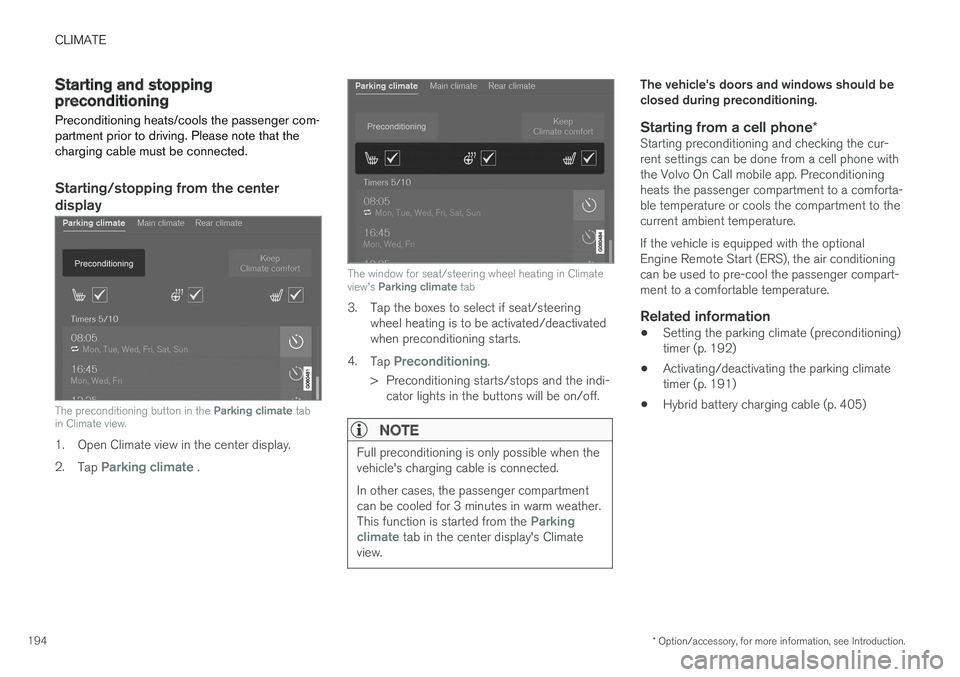
CLIMATE
* Option/accessory, for more information, see Introduction.194
Starting and stoppingpreconditioning
Preconditioning heats/cools the passenger com-partment prior to driving. Please note that thecharging cable must be connected.
Starting/stopping from the center
display
The preconditioning button in the Parking climate tabin Climate view.
1. Open Climate view in the center display.
2.Tap Parking climate .
The window for seat/steering wheel heating in Climateview's Parking climate tab
3. Tap the boxes to select if seat/steeringwheel heating is to be activated/deactivatedwhen preconditioning starts.
4.Tap Preconditioning.
>Preconditioning starts/stops and the indi-cator lights in the buttons will be on/off.
NOTE
Full preconditioning is only possible when thevehicle's charging cable is connected.
In other cases, the passenger compartmentcan be cooled for 3 minutes in warm weather.This function is started from the Parkingclimate tab in the center display's Climateview.
The vehicle's doors and windows should beclosed during preconditioning.
Starting from a cell phone *
Starting preconditioning and checking the cur-rent settings can be done from a cell phone withthe Volvo On Call mobile app. Preconditioningheats the passenger compartment to a comforta-ble temperature or cools the compartment to thecurrent ambient temperature.
If the vehicle is equipped with the optionalEngine Remote Start (ERS), the air conditioningcan be used to pre-cool the passenger compart-ment to a comfortable temperature.
Related information
•Setting the parking climate (preconditioning)timer (p. 192)
•Activating/deactivating the parking climatetimer (p. 191)
•Hybrid battery charging cable (p. 405)
Page 268 of 584

||
DRIVER SUPPORT
266
SymbolMessageDescription
ESC Temporarily offThe ESC system function has been temporarily reduced due to high brake disc temperature. The function reac-tivates automatically when the brakes have cooled.
ESC Service requiredThe ESC system is not functioning properly.
•Stop the vehicle in a safe place, turn off the engine and restart it.
•If the message is still displayed when the engine has restarted, drive to an authorized Volvo workshop tohave the system inspected.
WARNING
The stability system is intended to helpimprove driving safety. It supplements, but cannever replace, the driver's judgment andresponsibility when operating the vehicle.Speed and driving style should always beadapted to traffic and road conditions.
Related information
•Electronic Stability Control (ESC) (p. 263)
Page 305 of 584
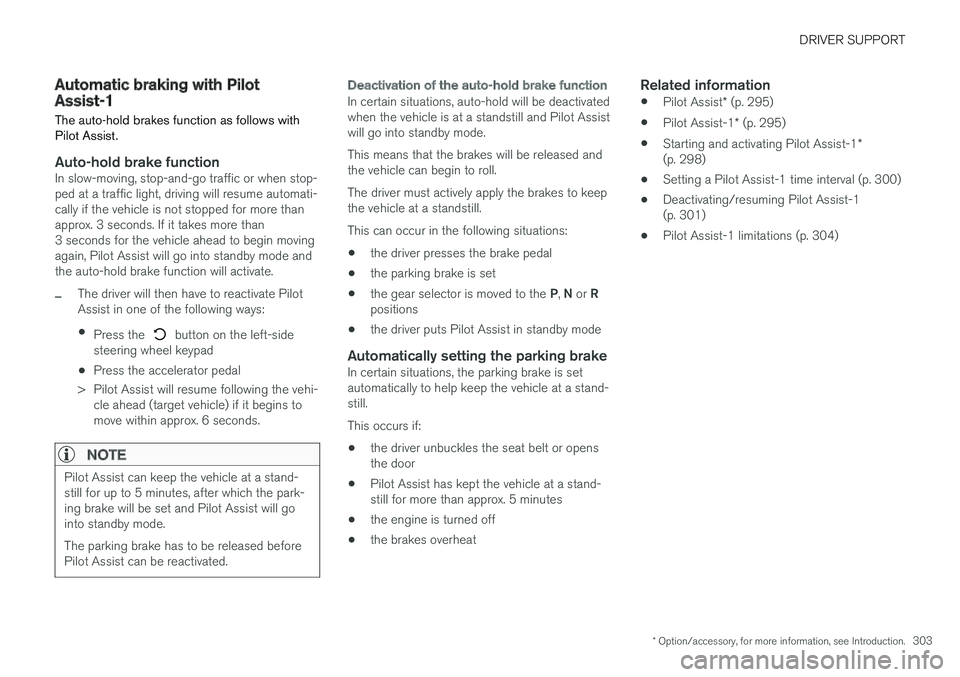
DRIVER SUPPORT
* Option/accessory, for more information, see Introduction.303
Automatic braking with PilotAssist-1
The auto-hold brakes function as follows withPilot Assist.
Auto-hold brake function
In slow-moving, stop-and-go traffic or when stop-ped at a traffic light, driving will resume automati-cally if the vehicle is not stopped for more thanapprox. 3 seconds. If it takes more than3 seconds for the vehicle ahead to begin movingagain, Pilot Assist will go into standby mode andthe auto-hold brake function will activate.
–The driver will then have to reactivate PilotAssist in one of the following ways:
•Press the button on the left-sidesteering wheel keypad
•Press the accelerator pedal
>Pilot Assist will resume following the vehi-cle ahead (target vehicle) if it begins tomove within approx. 6 seconds.
NOTE
Pilot Assist can keep the vehicle at a stand-still for up to 5 minutes, after which the park-ing brake will be set and Pilot Assist will gointo standby mode.
The parking brake has to be released beforePilot Assist can be reactivated.
Deactivation of the auto-hold brake function
In certain situations, auto-hold will be deactivatedwhen the vehicle is at a standstill and Pilot Assistwill go into standby mode.
This means that the brakes will be released andthe vehicle can begin to roll.
The driver must actively apply the brakes to keepthe vehicle at a standstill.
This can occur in the following situations:
•the driver presses the brake pedal
•the parking brake is set
•the gear selector is moved to the P, N or Rpositions
•the driver puts Pilot Assist in standby mode
Automatically setting the parking brake
In certain situations, the parking brake is setautomatically to help keep the vehicle at a stand-still.
This occurs if:
•the driver unbuckles the seat belt or opensthe door
•Pilot Assist has kept the vehicle at a stand-still for more than approx. 5 minutes
•the engine is turned off
•the brakes overheat
Related information
•Pilot Assist* (p. 295)
•Pilot Assist-1* (p. 295)
•Starting and activating Pilot Assist-1*(p. 298)
•Setting a Pilot Assist-1 time interval (p. 300)
•Deactivating/resuming Pilot Assist-1(p. 301)
•Pilot Assist-1 limitations (p. 304)
Page 360 of 584

DRIVER SUPPORT
* Option/accessory, for more information, see Introduction.358
Park Assist*
The Park Assist system is designed to assist youwhen driving into parking spaces, garages, etc.An audible signal and symbols in the instrumentpanel and center display indicate the distance tothe object.
Display view showing object zones and sensor sectors
The center display shows an overview of the vehi-cle in relation to objects that have been detected.
The highlighted sector shows which of the sen-sors has detected the object. The closer thehighlighted sector is to the vehicle symbol, thecloser the actual object is to your vehicle.
The Park Assist system uses an intermittent tonethat pulses faster as you come closer to anobject. Sound from the infotainment system willbe temporarily turned down.
The audible signals for objects in front of and tothe sides are active while the vehicle is movingand will stop after the vehicle has been stoppedfor approx. 2 seconds. The audible signals forobjects behind the vehicle are active even whenthe vehicle has stopped moving.
The audible signal becomes constant when youare within approximately 1 ft (30 cm) of an objectand the highlighted sensor field is filled in.
While an audible signal is being given, its volumelevel can be raised/lowered using the >II controlin the center console or can be adjusted in thecenter displays Top view under Settings.
NOTE
Audible alerts will only be provided for objectsthat are directly in the vehicle's path.
WARNING
Park Assist is an information system, NOT asafety system. This system is designed to bea supplementary aid when parking the vehicle.It is not, however, intended to replace the driv-er's attention and judgement.
Rear park assist
The system's rear sensors are activated automat-ically when the engine is started and are active ifthe vehicle rolls rearward with the gear selectorin N or if R has been selected.
The distance monitored behind the vehicle isapproximately 5 ft (1.5 m). The audible signalcomes from the rear speakers.
The rear sensors will be deactivated automaticallywhen towing a trailer if Volvo genuine trailer wir-ing is used. If a non-Volvo trailer hitch is beingused, it may be necessary to switch off the sys-tem manually.
Page 371 of 584

DRIVER SUPPORT
}}
* Option/accessory, for more information, see Introduction.369
WARNING
•PAP does not function in all situationsand is only intended to assist the driverduring parallel or perpendicular parking.
•As the driver, you have full responsibilityfor parking the vehicle in a safe manner.
Related information
•Using Park Assist Pilot (PAP)* (p. 369)
•Park Assist Pilot (PAP)* limitations (p. 372)
•Park Assist Pilot (PAP)* symbols and mes-sages (p. 374)
Using Park Assist Pilot (PAP)*
Park Assist Pilot (PAP) gives the driver instruc-tions during the parking procedure. The functioncan also assist when leaving a parking space.
NOTE
While PAP is active, the driver's task is to:
•carefully monitor the area around thevehicle
•follow the instructions provided in thecenter display
•select a gear (D or R) when prompted
•regulate the vehicle's speed
•apply the brakes when necessary andstop the vehicle
Symbols, images and text in the center displayindicate when the various steps in the parkingprocedure will be carried out.
PAP can be activated if the following conditionsare met after the engine has started:
•The vehicle may not be towing a trailer.
•The vehicle's speed must be below approx.20 mph (30 km/h).
•The distance between the vehicle and aparking space must be between 1.6-5.0 ft(0.5-1.5 m)
NOTE
If a trailer hitch is configured in the vehicle'selectrical system, PAP will take the trailerhitch into consideration when determining thenecessary size of a parking space.
Parking
Procedure for parking:
1. The system searches for and measures apossible parking space.
2. The vehicle is steered while it is backing intothe parking space.
3. The vehicle's position is adjusted in the park-ing space by moving forward and rearward.
Page 372 of 584
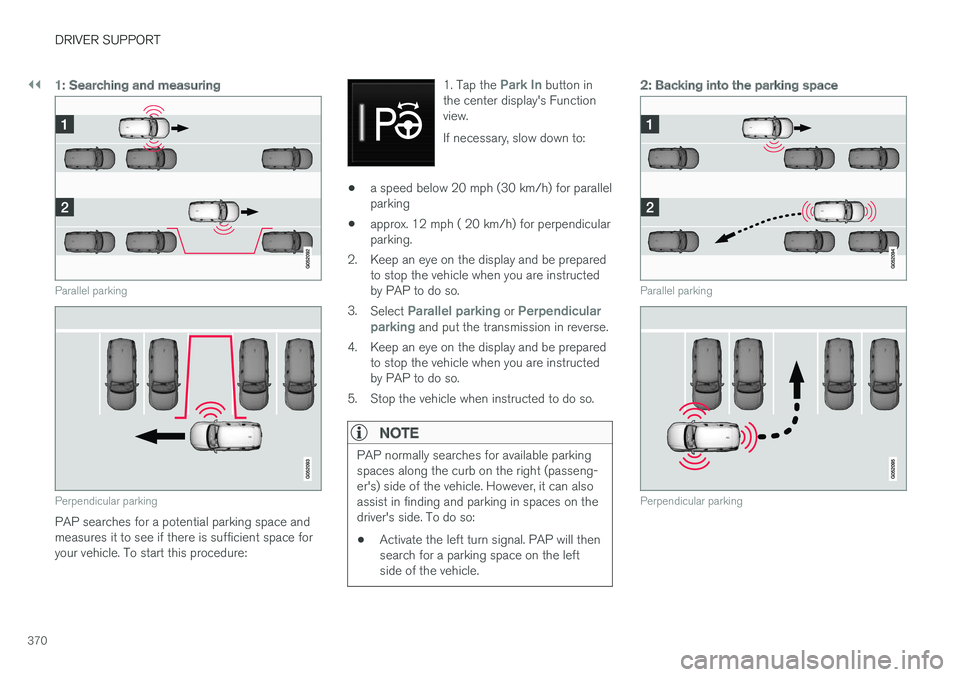
||
DRIVER SUPPORT
370
1: Searching and measuring
Parallel parking
Perpendicular parking
PAP searches for a potential parking space andmeasures it to see if there is sufficient space foryour vehicle. To start this procedure:
1. Tap the Park In button inthe center display's Functionview.
If necessary, slow down to:
•a speed below 20 mph (30 km/h) for parallelparking
•approx. 12 mph ( 20 km/h) for perpendicularparking.
2.Keep an eye on the display and be preparedto stop the vehicle when you are instructedby PAP to do so.
3.Select Parallel parking or Perpendicularparking and put the transmission in reverse.
4.Keep an eye on the display and be preparedto stop the vehicle when you are instructedby PAP to do so.
5. Stop the vehicle when instructed to do so.
NOTE
PAP normally searches for available parkingspaces along the curb on the right (passeng-er's) side of the vehicle. However, it can alsoassist in finding and parking in spaces on thedriver's side. To do so:
•Activate the left turn signal. PAP will thensearch for a parking space on the leftside of the vehicle.
2: Backing into the parking space
Parallel parking
Perpendicular parking
Page 378 of 584
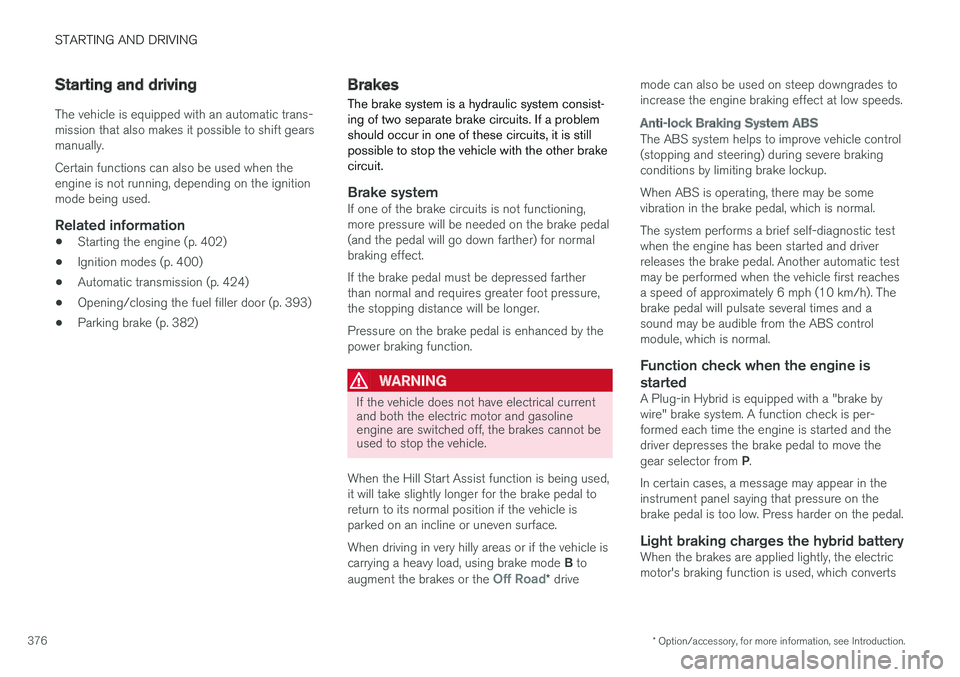
STARTING AND DRIVING
* Option/accessory, for more information, see Introduction.376
Starting and driving
The vehicle is equipped with an automatic trans-mission that also makes it possible to shift gearsmanually.
Certain functions can also be used when theengine is not running, depending on the ignitionmode being used.
Related information
•Starting the engine (p. 402)
•Ignition modes (p. 400)
•Automatic transmission (p. 424)
•Opening/closing the fuel filler door (p. 393)
•Parking brake (p. 382)
Brakes
The brake system is a hydraulic system consist-ing of two separate brake circuits. If a problemshould occur in one of these circuits, it is stillpossible to stop the vehicle with the other brakecircuit.
Brake system
If one of the brake circuits is not functioning,more pressure will be needed on the brake pedal(and the pedal will go down farther) for normalbraking effect.
If the brake pedal must be depressed fartherthan normal and requires greater foot pressure,the stopping distance will be longer.
Pressure on the brake pedal is enhanced by thepower braking function.
WARNING
If the vehicle does not have electrical currentand both the electric motor and gasolineengine are switched off, the brakes cannot beused to stop the vehicle.
When the Hill Start Assist function is being used,it will take slightly longer for the brake pedal toreturn to its normal position if the vehicle isparked on an incline or uneven surface.
When driving in very hilly areas or if the vehicle iscarrying a heavy load, using brake mode B toaugment the brakes or the Off Road* drive
mode can also be used on steep downgrades toincrease the engine braking effect at low speeds.
Anti-lock Braking System ABS
The ABS system helps to improve vehicle control(stopping and steering) during severe brakingconditions by limiting brake lockup.
When ABS is operating, there may be somevibration in the brake pedal, which is normal.
The system performs a brief self-diagnostic testwhen the engine has been started and driverreleases the brake pedal. Another automatic testmay be performed when the vehicle first reachesa speed of approximately 6 mph (10 km/h). Thebrake pedal will pulsate several times and asound may be audible from the ABS controlmodule, which is normal.
Function check when the engine is
started
A Plug-in Hybrid is equipped with a "brake bywire" brake system. A function check is per-formed each time the engine is started and thedriver depresses the brake pedal to move thegear selector from P.
In certain cases, a message may appear in theinstrument panel saying that pressure on thebrake pedal is too low. Press harder on the pedal.
Light braking charges the hybrid battery
When the brakes are applied lightly, the electricmotor's braking function is used, which converts
Page 379 of 584
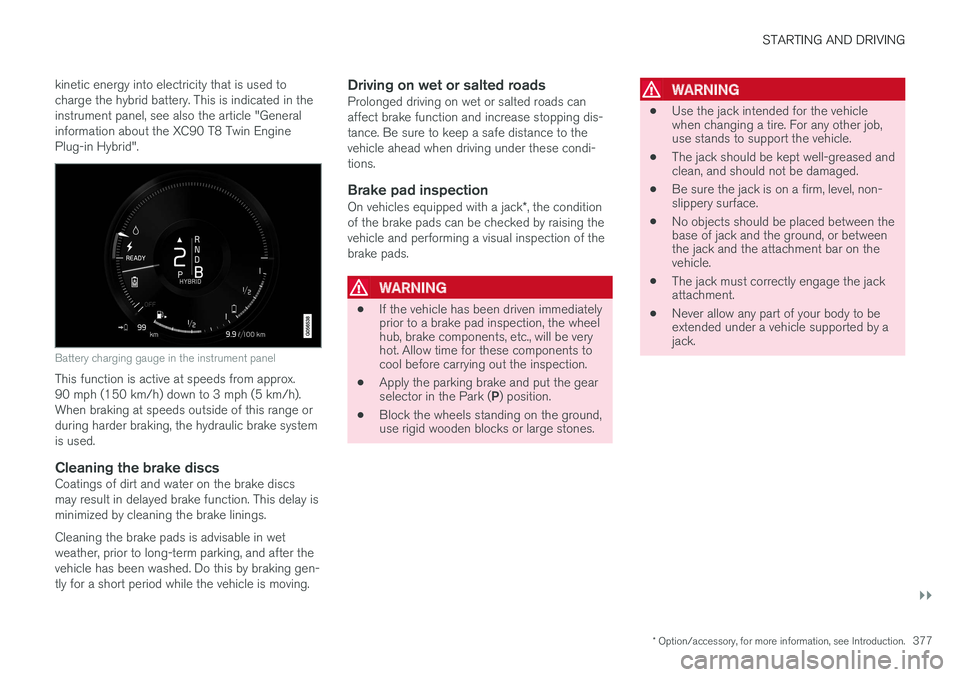
STARTING AND DRIVING
}}
* Option/accessory, for more information, see Introduction.377
kinetic energy into electricity that is used tocharge the hybrid battery. This is indicated in theinstrument panel, see also the article "Generalinformation about the XC90 T8 Twin EnginePlug-in Hybrid".
Battery charging gauge in the instrument panel
This function is active at speeds from approx.90 mph (150 km/h) down to 3 mph (5 km/h).When braking at speeds outside of this range orduring harder braking, the hydraulic brake systemis used.
Cleaning the brake discs
Coatings of dirt and water on the brake discsmay result in delayed brake function. This delay isminimized by cleaning the brake linings.
Cleaning the brake pads is advisable in wetweather, prior to long-term parking, and after thevehicle has been washed. Do this by braking gen-tly for a short period while the vehicle is moving.
Driving on wet or salted roads
Prolonged driving on wet or salted roads canaffect brake function and increase stopping dis-tance. Be sure to keep a safe distance to thevehicle ahead when driving under these condi-tions.
Brake pad inspection
On vehicles equipped with a jack*, the conditionof the brake pads can be checked by raising thevehicle and performing a visual inspection of thebrake pads.
WARNING
•If the vehicle has been driven immediatelyprior to a brake pad inspection, the wheelhub, brake components, etc., will be veryhot. Allow time for these components tocool before carrying out the inspection.
•Apply the parking brake and put the gearselector in the Park (P) position.
•Block the wheels standing on the ground,use rigid wooden blocks or large stones.
WARNING
•Use the jack intended for the vehiclewhen changing a tire. For any other job,use stands to support the vehicle.
•The jack should be kept well-greased andclean, and should not be damaged.
•Be sure the jack is on a firm, level, non-slippery surface.
•No objects should be placed between thebase of jack and the ground, or betweenthe jack and the attachment bar on thevehicle.
•The jack must correctly engage the jackattachment.
•Never allow any part of your body to beextended under a vehicle supported by ajack.
Page 381 of 584

STARTING AND DRIVING
379
Auto-hold brake function
With the Auto-hold brake function, the driver canrelease the brake pedal and the brakes willremain applied, for example, when the vehiclehas stopped at a traffic light or intersection.
When the vehicle is no longer moving forward,Auto-hold applies the brakes automatically, eitherusing the normal brakes or the parking brake.The brakes will be released when the acceleratorpedal is depressed.
If the driver's door is opened or the engine isturned off, the parking brake will be applied auto-matically.
Auto-hold control
Auto-hold control and indicator light
Turn Auto-hold on or off by pressing the controlin the tunnel console. The indicator light illumi-nates when the function is on.
When Auto-hold is off, Hill Start Assist (HSA) willbe activated to help prevent the vehicle from roll-ing backwards when starting up a hill.
Instrument panel symbol
SymbolExplanation
The symbol in the instrumentpanel illuminates when this func-tion is using the normal brakes tokeep the vehicle stationary.
A
B
This symbol in the instrumentpanel illuminates when Auto-holdis using the parking brake to keepthe vehicle stationary
AUS modelsBCanadian models
Related information
•Hill Start Assist (p. 381)
•Brake functions (p. 378)
Brake assist system
The Brake Assist System (BAS) increases brak-ing force, thereby helping reduce braking dis-tance.
The system monitors the driver's braking habitsand increases braking force when necessary.Brake force can be increased up to the point atwhich the ABS system is activated. The functionis deactivated when pressure on the brake pedaldecreases.
Related information
•Brakes (p. 376)
Page 382 of 584
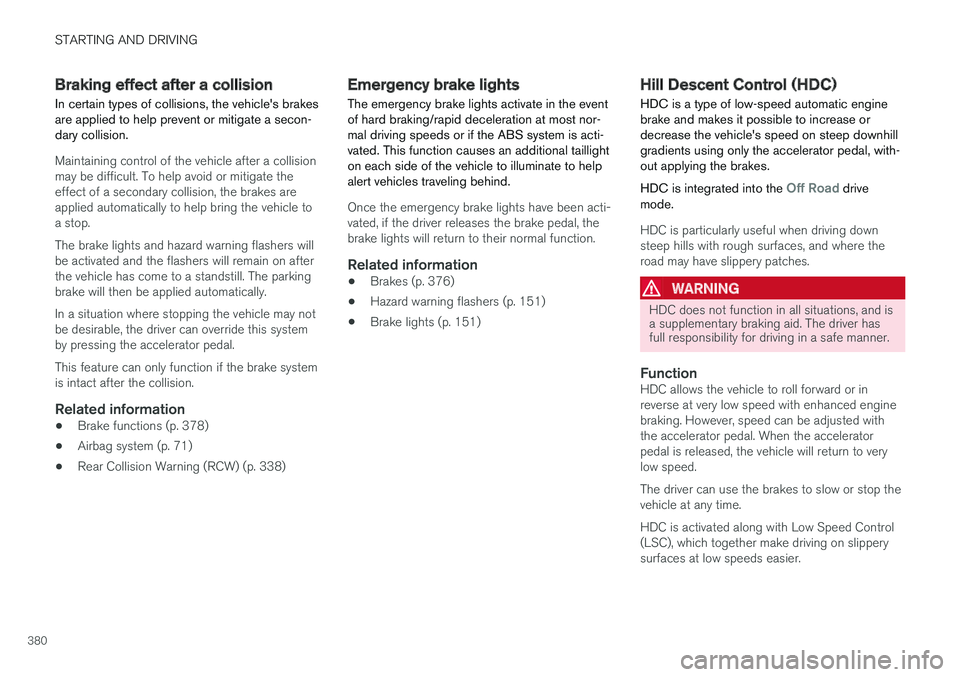
STARTING AND DRIVING
380
Braking effect after a collision
In certain types of collisions, the vehicle's brakesare applied to help prevent or mitigate a secon-dary collision.
Maintaining control of the vehicle after a collisionmay be difficult. To help avoid or mitigate theeffect of a secondary collision, the brakes areapplied automatically to help bring the vehicle toa stop.
The brake lights and hazard warning flashers willbe activated and the flashers will remain on afterthe vehicle has come to a standstill. The parkingbrake will then be applied automatically.
In a situation where stopping the vehicle may notbe desirable, the driver can override this systemby pressing the accelerator pedal.
This feature can only function if the brake systemis intact after the collision.
Related information
•Brake functions (p. 378)
•Airbag system (p. 71)
•Rear Collision Warning (RCW) (p. 338)
Emergency brake lights
The emergency brake lights activate in the eventof hard braking/rapid deceleration at most nor-mal driving speeds or if the ABS system is acti-vated. This function causes an additional taillighton each side of the vehicle to illuminate to helpalert vehicles traveling behind.
Once the emergency brake lights have been acti-vated, if the driver releases the brake pedal, thebrake lights will return to their normal function.
Related information
•Brakes (p. 376)
•Hazard warning flashers (p. 151)
•Brake lights (p. 151)
Hill Descent Control (HDC)
HDC is a type of low-speed automatic enginebrake and makes it possible to increase ordecrease the vehicle's speed on steep downhillgradients using only the accelerator pedal, with-out applying the brakes.
HDC is integrated into the Off Road drivemode.
HDC is particularly useful when driving downsteep hills with rough surfaces, and where theroad may have slippery patches.
WARNING
HDC does not function in all situations, and isa supplementary braking aid. The driver hasfull responsibility for driving in a safe manner.
Function
HDC allows the vehicle to roll forward or inreverse at very low speed with enhanced enginebraking. However, speed can be adjusted withthe accelerator pedal. When the acceleratorpedal is released, the vehicle will return to verylow speed.
The driver can use the brakes to slow or stop thevehicle at any time.
HDC is activated along with Low Speed Control(LSC), which together make driving on slipperysurfaces at low speeds easier.